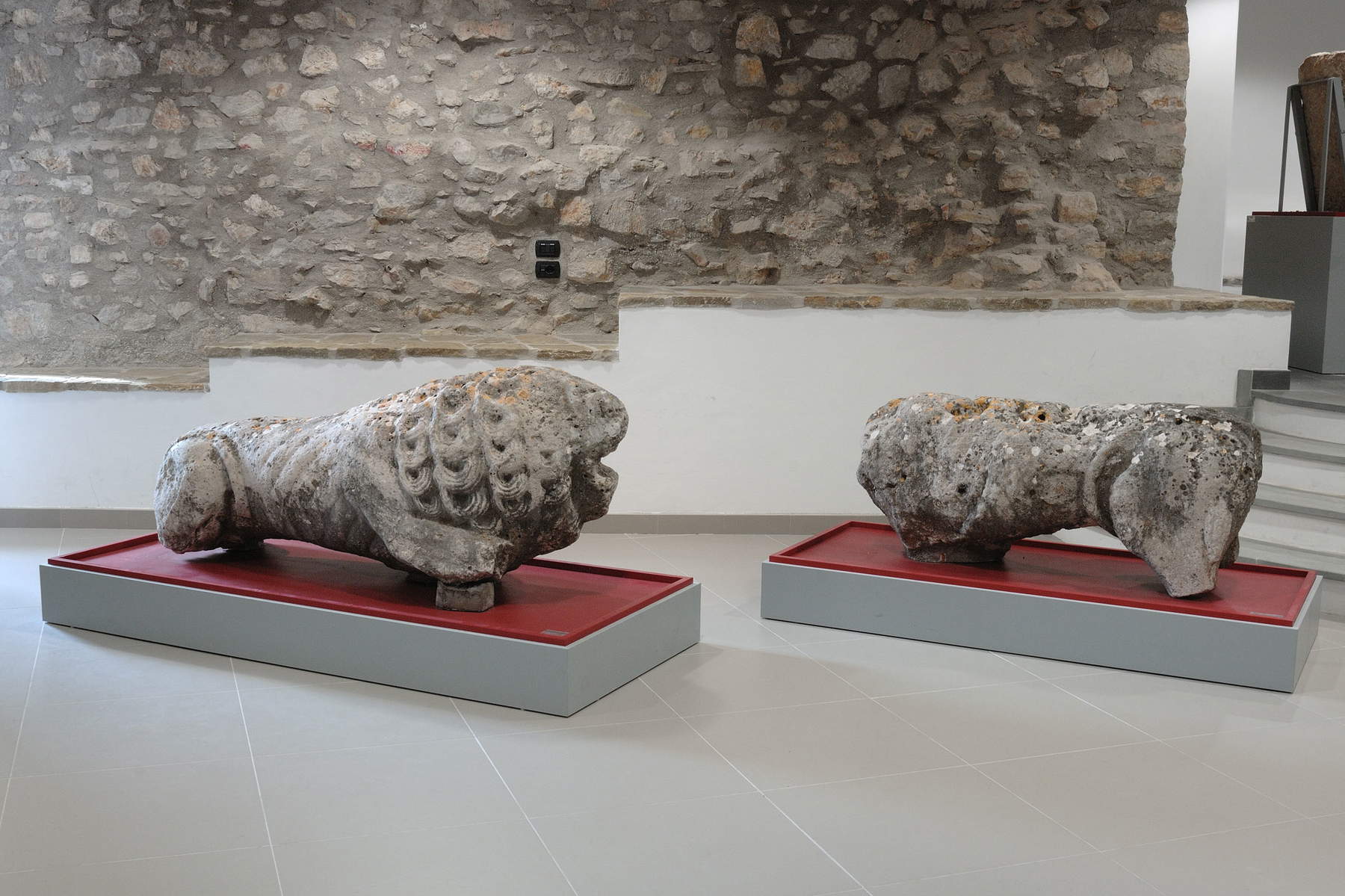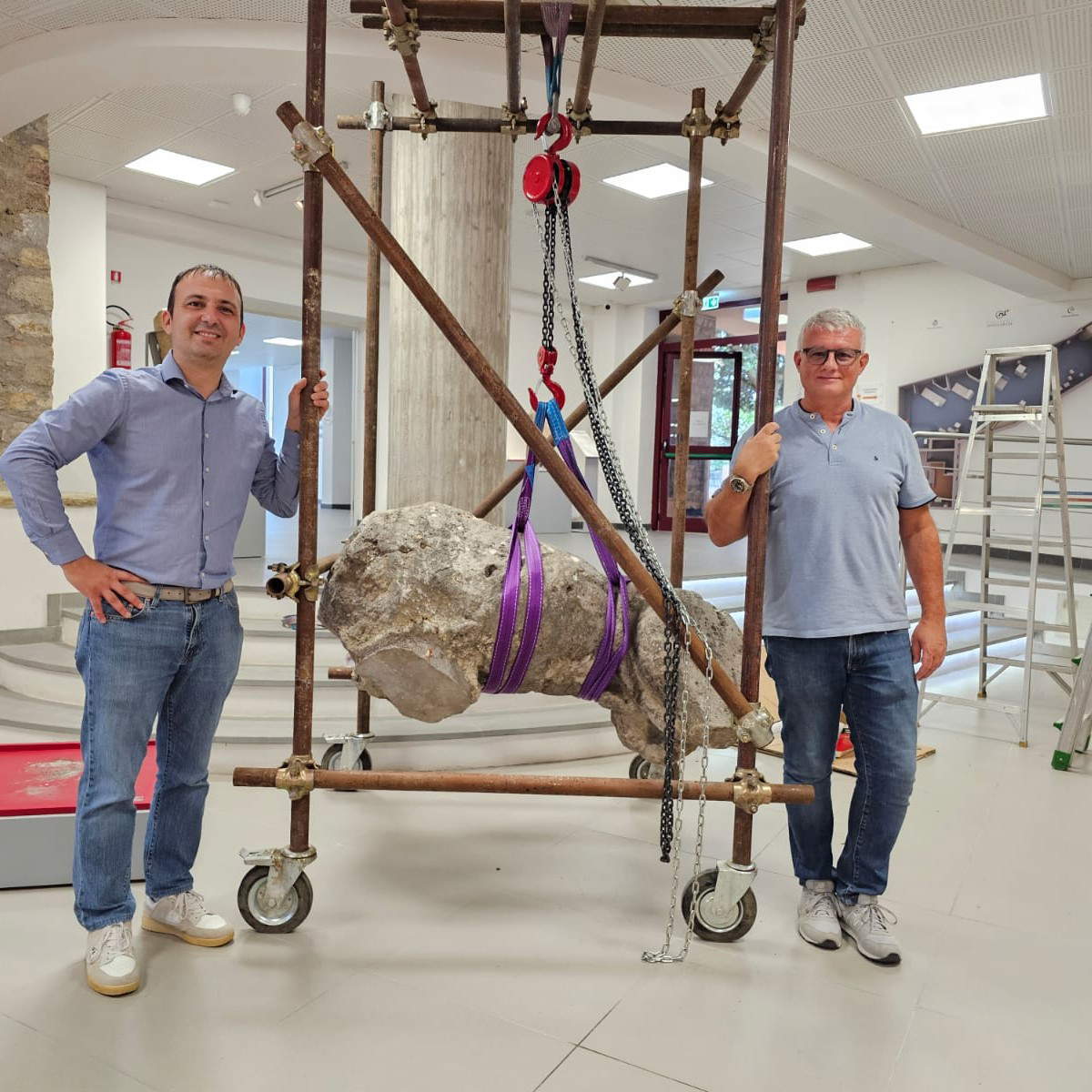For the first time in seven centuries the lions of Corciano, historic guardians of the Umbrian village in the province of Perugia, are leaving their city to undergo restoration. The operation, entrusted to specialized restorers and authorized by Perugia’s Soprintendenza Archeologia, Belle Arti e Paesaggio, kicks off in the coming days and should be completed by the end of the year. This is a step that combines protection, research and memory, since these two travertine sculptures, now kept at theAntiquarium of Corciano, have always been the symbol of entry to Corciano, as sentinels guarding its walls and history.
Their presence has been documented since the Middle Ages. The first news appear in the Latin Vatican Codex 4834, within the text known as The Account of Corciano and Perugia, which contains the legend of the foundation of the village by Coragino, companion of Ulysses. In these very pages a legend is told that would explain why one of the two lions appears with a scratched head. In fact, popular tradition tells of a boy who, afraid of the statues, dreamed every night of being mauled. His father, to reassure him, invited him to insert his hand into the mouth of one of the sculptures. But inside it lurked a scorpion that stung the boy, causing his death. The distraught father then broke the lion’s head, leaving the mark still visible today.
The origin of the lions is a matter of debate. According to one popular version, they were a war trophy brought back to Corciano in 1310 after the victory over Todi at Monte Molino. But studies suggest an older date. The specimens would date back to the classical age and could be a local product, already present in Corciano before the 14th century. Supporting this hypothesis is their consideration as “legendary” works as early as that time, and especially the petrographic correspondence between the travertine of the statues and that of the Strozzacapponi deposits, a few kilometers from the village. Analyses conducted in the late 1990s confirmed chemical and petrographic identities with Strozzacapponi-Santa Sabina travertine, consolidating the thesis of local production.


The sculptures watched over access to the village until at least after World War II, positioned facing the foot of the steps leading from Via Ballarini to Piazza dei Caduti. At the end of 2008, on the instructions of the Superintendence for Archaeological Heritage of Umbria, they were moved inside the municipal Antiquarium for conservation reasons. Since then, the void left by their absence has been deeply felt by the people of Corciano and tourists. In 2024, the municipality commissioned life-size copies, relocated to their historic location to restore the village to the image that has distinguished it over the centuries.
A stylistic analysis of the sculptures allows us to grasp their distinctive features. Both lions are depicted in a standing position, following a model typical of classical iconography.Specimen A is the best preserved. The left forepaw rests on the ground while the right is raised; the snout, slightly tilted downward and facing left, is partially worn but retains pronounced cheeks, frowning forehead and gaping jaws. The mane consists of four parallel bands of circular ringlets, each with five concentric curls, which are interrupted below the muzzle to give way to flame locks arranged in a radial pattern. Clear traces indicate the presence of a dorsal mane developed at least to mid-back.
Specimen B is more damaged, with the hind legs largely missing but still standing erect. It is on this lion that the head appears particularly compromised, consistent with the legendary account handed down through the centuries. Both show careful rendering of the musculature, both paws and ribs, with well-delineated anatomical details. In Specimen A, diffuse pores and less pronounced musculature can be seen on the left flank and back, perhaps due to wear or original placement that allowed a privileged view from one side only. Both retain traces of the tail, more visible in lion B: it descends from the back, inserts between the hind legs and goes up the left flank until it rests on the thigh, ending in an open tuft.
Symbolically, lions in ancient times were often associated with funerary monuments of noble families. They depicted power, vigilance and man’s ultimate destiny. Similar specimens, attested as early as the 6th century B.C. in the Punic area and later widespread in Greece and Etruria, show affinities with the Corcian lions, albeit with differences related to style and setting. Roman models, with a strong accentuation of the head and exaggerated naturalism, seem to have influenced the two Umbrian statues, albeit with decorative elements that deviate from classical rigor.
The type to which they can be traced is that of roaring lions with manes arranged in a radial pattern, sloping foreheads and gaping jaws. Some comparisons with specimens from Sassa, Parma and Perugia confirm their framing in a Central-Italic sphere that was particularly widespread between the 2nd century BCE and the imperial age. However, the rendering of the mane in the Corciano lions appears more decorative than naturalistic, but the accurate musculature and the twisting of the snout still restore a sense of dynamism.
Although the state of preservation makes precise dating difficult, scholars place the two sculptures in theRoman Imperial age. It is likely that they were originally part of a funerary architecture, confirming their symbolic function related to passage and protection. The transposition to medieval times and the attribution of an identity value to the village transformed two ancient artifacts into true guardians of the community.
Their restoration therefore represents an event of significance not only for Corciano, but for the entire Umbrian heritage. The operations will consolidate the surfaces, slow the processes of degradation and restore legibility to details worn out by time. Once the intervention is completed, the lions will once again become witnesses of the past and protagonists of the present, confirming the deep link between historical memory, popular tradition and collective identity.
 |
| Corciano lions leave village after seven centuries for historic restoration |
Warning: the translation into English of the original Italian article was created using automatic tools. We undertake to review all articles, but we do not guarantee the total absence of inaccuracies in the translation due to the program. You can find the original by clicking on the ITA button. If you find any mistake,please contact us.